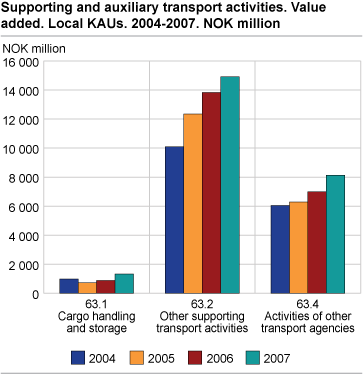Content
Published:
Continued growth in auxiliary transport activities
A total of 2 456 local kind-of-activity units (KAU) in supporting and auxiliary transport activities generated a total of NOK 24.4 billion of value added in 2007; an increase of 12.4 per cent from 2006.The industry employed 26 864 persons in 2007.
Auxiliary transport activities. Value added
Supporting and auxiliary transport activities are made up of three industry classes; cargo handling and storage, other supporting transport activities, and other transport agencies. Of the total value added in 2007, cargo handling made up 51.3 per cent, supporting activities 7.8 per cent and transport agencies 16.8 per cent.
Better for operating margins
The cargo handling and storage industry had its first year of operating income exceeding operating costs. In 2007, the industry registered an operating income of NOK 3.72 billion and had operating costs of NOK 3.66 billion. Due to the entry of a few large enterprises the industry noted a 51.3 per cent increase in value added, from NOK 880 million in 2006 to NOK 1.331 million in 2007.
Activities of other transport agencies had a 6.9 per cent operating margin in 2007 compared with 6 per cent in 2006. The operating margin for Other transport activities fell from 12 per cent in 2006 to 11.2 per cent in 2007. It is mainly this industry class that is driving the operating margin up for supporting and auxiliary transport activities overall.
Growth for air transport activities
Among supporting air transport activities (SIC 63.23) we find enterprises that operate airports, service operators of foreign airlines and aviation supervision. This is the biggest industry class in supporting and auxiliary transport activities in terms of value added, with NOK 7.7 billion in 2007. Value added for air transport is NOK 6.8 billion. Norwegians do a great deal of travelling so it should come as no surprise that this is a big industry. Read more about the holiday habits of the Norwegians.
Travel services
Activities of travel agencies, tour operators and tourist assistance activities are not included in these figures. Statistics for this industry group are published independently.
Corporate restructuring in scheduled air transportIn other supporting air transport activities (63.23) the figures for 2005 are affected by the corporate restructuring of SAS that took effect in October 2004. For more on this see “ Corporate Restructuring within SAS and Structural Business Statistics at SSB ”. |
Statistics on the enterprise levelThe structural business statistics for land transport are compiled both on the local KAU level and on the enterprise level. Figures on the enterprise level will usually deviate from figures on the local KAU level. This is due to the fact that the enterprises are registered in the industry subclass that comprises the main part of the activity of the enterprise, and therefore may be registered in a different industry than some of the local KAUs. Revision of industriesIn 2007 and 2008, the enterprises in Statistics Norway’s Central Register of Establishments and Enterprises were coded in accordance with the new Standard Industrial Classification (SN2007). This has revealed some incorrectly classified enterprises and local KAUs. In such cases, the code according to the current standard (SN2002) has been revised. The new Standard Industrial Classification (SN2007) will be used for the first time in the publishing of preliminary figures for the statistical year of 2008, in October 2009. Descriptions of the classifications are available here . |
Tables:
- Table 1 Supporting and auxiliary transport activities. Principal figures, by industry subclass. Local kind-of-activity units. 2007
- Table 2 Supporting and auxiliary transport activities. Principal figures, by number of persons employed and industry group. Local kind-of-activity units. 2007
- Table 3 Supporting and auxiliary transport activities (NACE 63 ). Principal figures, by county. Local kind-of-activity units. 2007
- Table 4 Supporting and auxiliary transport activities. Principal figures, by industry subclass. Enterprises. 2007
- Table 5 Supporting and auxiliary transport activities. Principal figures, by number of persons employed and industry group. Enterprises. 2007
The statistics is now published as Business statistics.
Contact
-
Statistics Norway's Information Centre
E-mail: informasjon@ssb.no
tel.: (+47) 21 09 46 42

